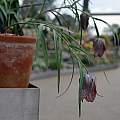Fritillaria orientalis Adam (syn. Fritillaria tenella M.Bieb.) was first described by Johann Friedrich Adam in 1805, based on specimens collected in Ossetia. Endemic to the Great Caucasus it is found on north facing limestone crevices, flowering June to early July, 1700-3000 m.
Photograph by Laurence Hill in April 2011 on display in the Davies Alpine House in the Royal Botanic Garden, Kew. The plant is displaying the typical habit of Fritillaria orientalis in the wild where it is found on cliff edges on north facing slopes in the Russian Caucasus. As a result of this habit of hanging over the side of a pot it is infrequently seen at shows although it is easy to cultivate. Most plants sold as Fritillaria tenella are Fritillaria montana. The Flora Europaea (1980) placed the very variable Fritillaria montana as a synonym of Fritillaria orientalis despite differences in morphology, cytology and distribution.
Fritillaria orientalis
Bulb: with/without bulblets
Leaves: canaliculated
Perianth segments: apex obtuse, without fascia
Capsule: distinctly 6-angled
Chromosome number: 2n = 24
Distribution: endemic to Southern Russia
Frtillaria montana
Bulb: with a single stolon arising from the major scale
Leaves: flat
Perianth segments: apex pointed, with fascia
Capsule: somewhat 6-angled
Chromosome number: 2n = 18
Distribution: SE France, Italy, the Balkans, Northern Greece, SW Ukraine with a single location reported in South West Turkey.
